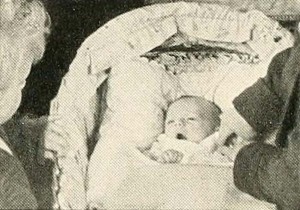
"With Number Three Arrives, John Martin carries on the continuity both of his charming family and of his delightful films of them, so ably introduced by his last year's award winner, A Day with the Young Martins. Here again are the sure feeling for cinematic story technique, the nicely effective angles and the smooth sequencing which belies any need for titles. Added to these deft and familiar abilities of Mr. Martin's work, the current production brings to light a delightful flair for farce comedy by the harassed father and a family terrier rivaling, on a small scale, the best of Hollywood's canine thespians. Once more, Mr. Martin has proved beyond argument that a well planned family film may be of interest to all who see it." Movie Makers, Dec. 1937, 630.
"A fun time is in store for the smartly dressed women disembarking from the bus, in this lovely film from 1929. Joshua Preston, Mayor of Stockport, entertains a group of nurses at Glengarry, his family home, with a garden tour, and games and races, followed by tea on the lawn. With music as well, this makes for a grand afternoon out. The reel ends with the Preston family in the Glengarry garden." (BFI Player)
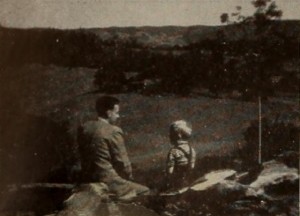
"Five years before the action of The Old House opens, a young man and his bride of but a year had been involved in a train wreck. The bride, Claire, was killed: but the man — scarred in mind, bruised in body and (he thought) dependent on a walking stick — lived on. He comes now, as the film begins, for one last look at the Old House, "the Old House where I was born and grew up, where Claire and I had been so happy for one short year, with hopes and plans for a future that never came." But, instead of viewing (with self-inflicted sadness) his old homestead, he meets accidentally with a brightfaced boy of five, son of his widowed tenant. How this youngster, this "artless wisdom dressed in blue jeans," frees the man from his stick (a mere surface symbol of his bondage) and from his obsession with the past is the theme of The Old House. But it is fruitless always to attempt a factual outline of any visual study in human relations. And, heartwarmingly, believably and triumphantly, The Old House is simply and exactly that. The producer, Keith Hall, has plotted the course of his tenuous drama with a sure touch and unfailing taste. His scenic progressions are so artful as to seem artless, while his camera work and narrative exposition never fail him in the delicate unfolding of his denouement. Yet it is to the three players of this picture — and to their narrator — that the ultimate tributes must be paid. Young Ross Hall as the Boy, Noela Hall as his widowed Mother, and Mr. Hall himself as the Man are exactly and exquisitely right in their restrained underplaying of three diflicult roles. Reg Cameron, the narrator, speaks lines which are always literate, and often lyric, with warmth and understanding. From its simple opening to its quietly soaring climax, The Old House is a tender and moving triumph." Movie Makers, Dec. 1953, 318-319.
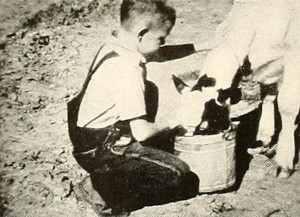
"On the Farm, made by Mr. and Mrs. Ray Garner for the Harmon Foundation, is an example of visual education at its best. By the use of two charming, healthy little American children as the chief characters, it enlists sympathy before it attempts to instruct. And it never strays from the fundamental concept which, to all evidence, was in the minds of its makers: namely that, to teach children by visual aids, one must appeal to their sense of fun. Charm, here, is not outlawed simply because it is not informative. Divided into two parts, Morning and Afternoon, and illustrated with unpretentious titles, such as This is how the animals help, which are chalked in white letters on a blackboard, On the Farm tells of a common workday, in terms of what two farm children can do to assist their parents. From the sequence in which the tousled farm lad puts his head out of the window to see what kind of a daybreak it is. to the time when the sun goes down behind the silo, almost every kind of farm activity is shown. Other children in city classrooms are going to see themselves in the scenes and will want to learn more about a way of life in which they can feel so much at home." Movie Makers, Dec. 1940, 600-601.
"Groups of people assemble in town, meeting and chatting on the street. At the beach, women feed the seagulls, go on a fairground boat ride, and they feed chips to the gulls both on the beach and from a wooden pier, A family assemble in the garden - the girls are wearing school uniform - and sit together. There is a shot of horned cattle in a field, and there is a garden where an old man mows his lawn, while a very old man receives a buttonhole. The location shifts to a clifftop walk. In what seems like an earlier period, very formally dressed people play with a small child, and sit in deckchairs" (NWFA Online Database).
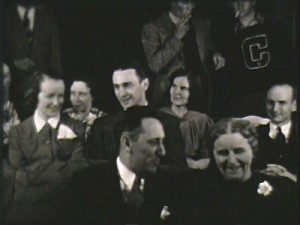
"Brief 1938 film of family and friends descending stairs into the cellar, followed by pan across the seated audience." oldfilm.org
"Our Friendly Enemies: This unique title has its origin in the fact that the Seminoles are the only native American Indians who have never signed a peace treaty with the government. Ralph E. Gray has chronicled in color with his 16mm Cine Special camera the contemporary life of the Seminoles living in Florida, picturing their activities against the backdrop of modern-day living and habits. Gray's reputation for camera and good editing has resulted in very professional results on the screen. Narration and sound effects on the recorded track round out the superior treatment of this better than average amateur effort." American Cinematographer, May 1951, 190.
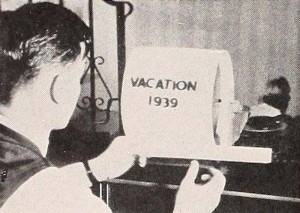
"When movie makers turn to movie making itself as the subject of a picture, sometimes they are a little self conscious and heavy handed — more particularly if the approach is humorous. This fault, the Dallas (Texas) Cine Club has successfully avoided in Out to Win, an opus that displays the adventures of a new convert to filming. The hero of the tale observes that everybody has a movie camera and that he is out of things. So his trombone and the equipment of other hobbies go to the "hock shop" to finance the purchase of a new cine camera. His wife isn't particularly sympathetic to movie making, and here the real humor enters, for Mrs. Movie Maker is not antagonistic; she is just oblivious to the real importance of movies. She walks in on her husband when he is developing titles, she tramps through film clips when he is editing; but, when the movie maker receives an incredible sum for a newsreel scoop (well handled airplane wreck sequence) and, in consequence, gets a check that enables the pair to buy a new car, Mrs. Movie Maker's attitude changes. In the last scene, she is proudly using a camera. The actors are excellent: they do not overplay their roles, and so the film is really funny." Movie Makers, Dec. 1939, 634-635.
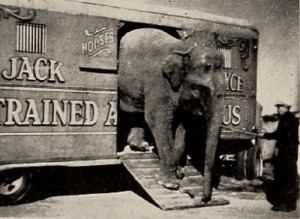
"What happens behind the scenes is always of interest to curious people — and most of us are curious. Remembering the delighted boys who sometimes get odd jobs in the backyard of the circus, Guy Nelli elected to let us see what they have seen, in Outside the Big Top. Not once are we shown the performance for which the whole effort is made, since Mr. Nelli very properly stays outside with his camera. Beginning with interesting and well filmed scenes of the circus in its early morning arrival, Mr. Nelli shows us how the Big Top is set up and carries us along until the show has ended. Odds are that he is a persuasive talker as well as a fine movie maker, because he got some of the best portrait and "candid" scenes of the performers that one will meet in many a day." Movie Makers, Dec. 1945, 496.
"Scenes from Croston village pageant, Saturday May 26th, 1951 - adults and children are seen in medieval dress, acting out scenes from the area's history. A number of 'Coffee Day' parades from 1937 to 1970 are shown, with Church groups and floats passing through the streets. The film ends with a man and two women in the garden of a house in Steyning, West Sussex." (NWFA Online Archive)
Total Pages: 29